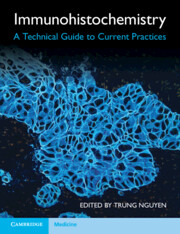Book contents
- Immunohistochemistry
- Immunohistochemistry
- Copyright page
- Dedication
- Contents
- Contributors
- Preface
- Chapter 1 Immunohistochemistry Fundamentals
- Chapter 2 Immunohistochemistry Quality Assurance and Quality Control
- Chapter 3 Automation and Robotics with the Leica Bond III
- Chapter 4 Automation and Robotics with the Roche Ventana BenchMark ULTRA
- Chapter 5 Automation and Robotics with the Agilent Dako Omnis
- Chapter 6 Immunohistochemistry for Research Applications
- Chapter 7 Troubleshooting Immunohistochemistry
- Chapter 8 Current Status of Immunohistochemistry
- Chapter 9 Immunohistochemistry for Future Applications
- Index
- References
Chapter 6 - Immunohistochemistry for Research Applications
Published online by Cambridge University Press: 16 June 2022
- Immunohistochemistry
- Immunohistochemistry
- Copyright page
- Dedication
- Contents
- Contributors
- Preface
- Chapter 1 Immunohistochemistry Fundamentals
- Chapter 2 Immunohistochemistry Quality Assurance and Quality Control
- Chapter 3 Automation and Robotics with the Leica Bond III
- Chapter 4 Automation and Robotics with the Roche Ventana BenchMark ULTRA
- Chapter 5 Automation and Robotics with the Agilent Dako Omnis
- Chapter 6 Immunohistochemistry for Research Applications
- Chapter 7 Troubleshooting Immunohistochemistry
- Chapter 8 Current Status of Immunohistochemistry
- Chapter 9 Immunohistochemistry for Future Applications
- Index
- References
Summary
This chapter is written for the researcher who may encounter immunohistochemistry (IHC) in a slightly different context when compared to diagnostic applications. There are many moving parts to IHC assays, and this chapter covers all of the important aspects the researcher needs to consider when employing IHC for their projects. This objective is achieved by employing a request form for IHC services. The questions posed on the form build towards piecing together a protocol that is fit for purpose and can be used in many applications. Practical explanations about epitope retrieval, diluting antibodies from concentrates and the use of detection kits are provided. The need to block endogenous enzyme activity is also explained, as is the technique for antibody optimization. Borrowing the basic fundamental IHC protocol used in diagnostic histopathology, the researcher should be able to adopt and change parameters to suit their research applications.
Keywords
- Type
- Chapter
- Information
- ImmunohistochemistryA Technical Guide to Current Practices, pp. 160 - 182Publisher: Cambridge University PressPrint publication year: 2022

